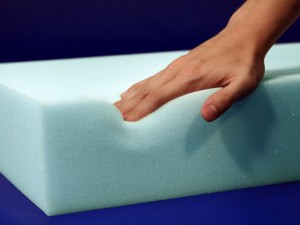Learn about the differences between firmness and density for foam products.
 When you’re researching foam for custom cushions, or any other project, you’ll find that you have a lot of options when it comes to the type of foam you can use and the density of that foam. One thing you’ll notice is that foam has a density and a firmness. While it’s logical to equate the two as similar, they are quite different and can lead to different properties. This guide will walk you through what high density foam actually is, and how that relates to the softness of the padding.
When you’re researching foam for custom cushions, or any other project, you’ll find that you have a lot of options when it comes to the type of foam you can use and the density of that foam. One thing you’ll notice is that foam has a density and a firmness. While it’s logical to equate the two as similar, they are quite different and can lead to different properties. This guide will walk you through what high density foam actually is, and how that relates to the softness of the padding.
Foam Density
Latex and memory foam both tend to be high density foam sheets, although you can order lower density versions. Most people tend to get the higher density varieties of these foam sheets for the support they give. High density foam basically have smaller openings between each foam cell. When you compress those cells, they don’t lose as much of their shape (or density) as a lower density foam sheet would. Wider cells can help prevent moisture, though, so outdoor foam tends to have wide open cells.
Softness
When we discuss firmness, or softness, what we’re referring to is the way the foam feels to the touch. Firmness really depends on preference, but there are other components to keep in mind. If you’re overweight, you might bottom out on a cushion that is less dense. That would basically make your new cushion a moot point, so higher density foam designed for soft touch would be more effective.
You should also consider how you’ll use that foam. Foam in a boat cushion, for example, tends to be used for sitting in short periods. Mattress foam might see several hours of continuous use, so it’s best to choose a density that you won’t sink into over time.
Foam Factory, Inc. sells polyurethane foam to Canada and the United States, with packaging foam, bedding, mattress toppers and more available online.
